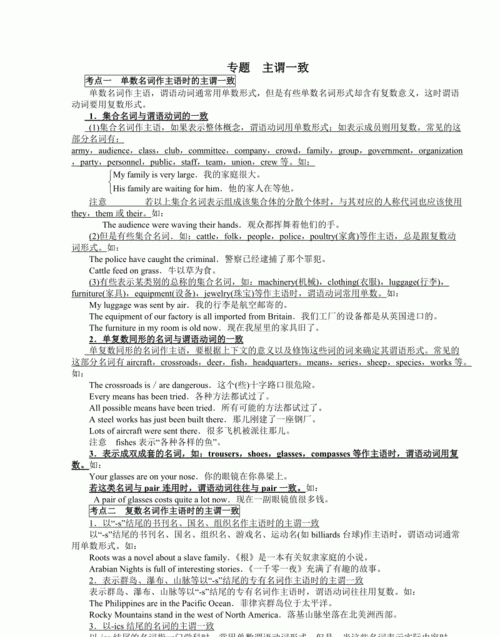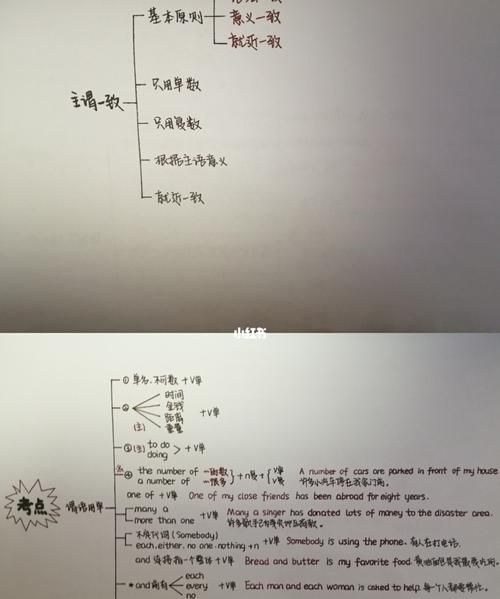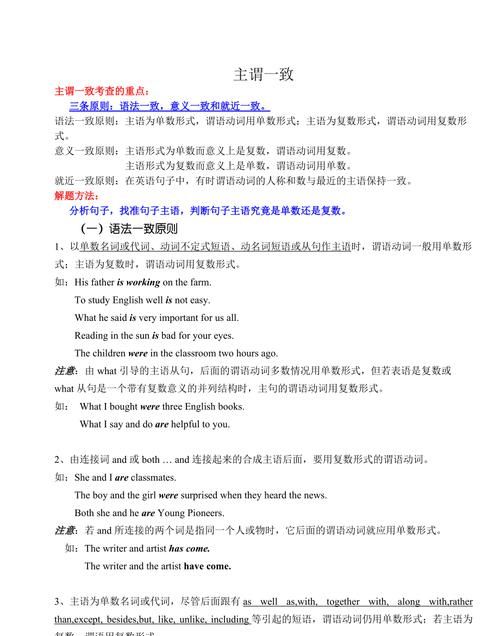本文目录
and主谓一致的用法
在英语句子里,谓语受主语支配,其动词必须和主语在人称和数上保持一致,这就叫主谓一致。寻其规律,大致可归纳为三个原则,即语法一致、逻辑意义一致和就近一致原则。
一、就近一致原则
在英语句子中,有时谓语动词的人称和数与最近的主语保持一致。
1. 当两个主语由either …… or, neither …… nor, whether …… or ……, not only …… but also连接时,谓语动词和邻近的主语一致。如:Either the teacher or the students are our friends. / Neither they nor he is wholly right. / Is neither he nor they wholly right?
2. there be句型be动词单复数取决于其后的主语。如果其后是由and连接的两个主语,则应与靠近的那个主语保持一致。如:There are two chairs and a desk in the room.
注意:Here引导的句子用法同上。
二、语法一致原则
语法上一致就是谓语动词和主语在单、复数形式上保持一致。
1. 以单数名词或代词、动词不定式短语、动名词短语或从句作主语时,谓语动词一般用单数形式;主语为复数时,谓语动词用复数形式。如:His father is working on the farm. / To study English well is not easy. / What he said is very important for us all. / The children were in the classroom two hours ago. / Reading in the sun is bad for your eyes.
注意:由what引导的主语从句,后面的谓语动词多数情况用单数形式,但若表语是复数或what从句是一个带有复数意义的并列结构时,主句的谓语动词用复数形式。如:What I bought were three English books. / What I say and do is (are) helpful to you.
2. 由连接词and或both …… and连接起来的合成主语后面,要用复数形式的谓语动词。如:Lucy and Lily are twins. / She and I are classmates. / The boy and the girl were surprised when they heard the news. / Both she and he are Young Pioneers.
注意:(1)若and所连接的两个词是指同一个人或物时,它后面的谓语动词就应用单数形式。如:The writer and artist has come. (2)由and连接的并列单数主语前如果分别有no, each, every more than a (an) , many a (an)修饰时,其谓语动词要用单数形式。如:Every student and every teacher was in the room. / No boy and no girl likes it.
3. 主语为单数名词或代词,尽管后面跟有with, together with, except, but, like, as well as, rather than, more than, no less than, besides, including等引起的短语,谓语动词仍用单数形式;若主语为复数,谓语用复数形式。如:Mr. Green, together with his wife and children, has come to China. / Nobody but Jim and Mike was on the playground. / She, like you and Tom, is very tall.
4. either, neither, each, every 或no +单数名词和由some, any, no, every构成的复合不定代词,都作单数看待。如:Each of us has a new book. / Everything around us is matter.
注意:(1)在口语中当either或neither后跟有“of+复数名词(或代词)”作主语时,其谓语动词也可用复数。如:Neither of the texts is (are) interesting. (2)若none of后面的名词是不可数名词,它的谓语动词就要用单数;若它后面的名词是复数,它的谓语动词用单数或复数都可以。如:None of us has (have) been to America.
5. 在定语从句时,关系代词that, who, which等作主语时,其谓语动词的数应与句中先行词的数一致。如:He is one of my friends who are working hard. / He is the only one of my friends who is working hard.
6. 如果集体名词指的是整个集体,它的谓语动词用单数;如果它指集体的成员,其谓语动词就用复数形式。这些词有family, class, crowd, committee, population, audience等。如:Class Four is on the third floor. / Class Four are unable to agree upon a monitor.
注意:people, police, cattle等名词一般都用作复数。如:The police are looking for the lost child.
7. 由“a lot of, lots of, plenty of, the rest of, the majority of + 名词”构成的短语以及由“分数或百分数+名词”构成的短语作主语,其谓语动词的数要根据短语中后面名词的数而定。如:There are a lot of people in the classroom. / The rest of the lecture is wonderful. / 50% of the students in our class are girls.
注意:a number of“许多”,作定语修饰复数名词,谓语用复数;the number of“……的数量”,主语是number,谓语用单数。
8. 在倒装句中,谓语动词的数应与其后的主语一致。如:There comes the bus. / On the wall are many pictures. / Such is the result. / Such are the facts.
三、逻辑意义一致原则
逻辑意义一致就是谓语动词的数必须和主语的意义一致(因有时主语形式为单数,但意义为复数;有时形式为复数,但意义为单数)。
1. what, who, which, any, more, all等代词可以是单数,也可是复数,主要靠意思来决定。如:Which is your bag? / Which are your bags? / All is going well. / All have gone to Beijing.
2. 表示“时间、重量、长度、价值”等的名词的复数作主语时,谓语动词通常用单数形式,这是由于作主语的名词在概念上是一个整体,如:Thirty minutes is enough for the work.
3. 若英语是书名、片名、格言、剧名、报名、国名等的复数形式,其谓语动词通常用单数形式。如:“The Arabian Nights” is an interesting story-book.
4. 表数量的短语“one and a half”后接复数名词作主语时,其谓语动词可用单数形式(也可用复数。如:One and a half apples is (are) left on the table.
5. 算式中表示数目(字)的主语通常作单数看待,其谓语动词采用单数形式。如:Twelve plus eight is twenty. / Fifty-six divided by eight is seven.
6. 一些学科名词是以 –ics 结尾,如:mathematics, politics, physics 以及news, works等,都属于形式上是复数的名词,实际意义为单数名词,它们作主语时,其谓语动词要用单数形式。如:The paper works was built in 1990. / I think physics isn‘t easy to study.
7. trousers, glasses, clothes, shoes, 等词作主语时,谓语用复数,但如果这些名词前有a (the) pair of等量词修饰时,谓语动词用单数。如:My glasses are broken. / The pair of shoes under the bed is his.
8. “定冠词the + 形容词或分词”,表示某一类人时,动词用复数。

主谓一致的各种情况及例句英语
一般情况下,主谓之间的一致关系由以下三个原则的支配: 语法一致原则、 意义一致原则和就近原则。
一、语法一致
主谓一致的原则是指主语和谓语从语法形式上取得一致:主语是单数形式,谓语也采取单数形式;主语是复数形式,谓语亦采取复数形式。例如:
He often helps me learn English. (主语是单数形式,谓语也采取单数形式) 。
My friends often help me learn English. (主语是复数形式,谓语也采取复数形式)
但主语和谓语从语法形式上取得一致的问题远不只上述的那么简单,有许多方面的情况需要去具体地对待:
1、不定式,动名词,以及从句作主语时应看作单数,谓语动词用单数。
例如:Reading aloud is helpful to learn English.大声朗读对学习英语是有帮助的。
What he said has been recorded .他说的话已被录音了。
2、不定代词one, every, each, everybody, everyone, one of, no one, nothing, nobody, someone, somebody, either, neither, many a 等作主语或是修饰主语时应看作单数,谓语动词用单数。但none 作主语时,谓语动词既可用单数也可用复数,这要取决于说话人的看法。
例如:Neither of my sisters likes sports .我的妹妹中没人喜欢运动。
Every boy and girl shows great interest in this book .每个男孩和女孩对这本书都表现出很大的兴趣。
3、表示国家,机构,事件,作品等名称的专有名词作主语时应看作单数,谓语动词用单数。
例如:One Thousand And One Nights tells people lots of interesting stories . 《一千零一夜》给人们讲了许多有趣的故事。
4、a kind of, the number of等与名词构成名词短语作主语时应看作单数,谓语动词用单数。
例如:The number of workers in the factory is 400. 这个工厂里工人的数量是400.
A kind of rose in the garden smells very pleasant.这座花园里有一种玫瑰香气怡人。
5、由some, several, both, few, many, a number of 等词修饰主语,或是由它们自身作主语时应看作复数,谓语动词用复数。另外,由and连接两个主语时,谓语一般用复数。
例如:On the seashore, some people are playing volleyball 海边,有些人在打排球。
Both of us are fond of watching football games .我们俩都喜欢看足球赛。
A number of will-be graduates are voluntarily going to work in the West of China. 许多即将毕业的学生打算自愿去中国西部工作。
6、有些表示数量的百分数,分数等后面加名词或代词作主语时,要根据这个名词或代词来决定其谓语动词的单复数形式。如:a lot of, most of, any of, half of, three fifths of, eighty percent of, some of, none of, the rest of , all of等后接不可数名词,或是单数形式的名词作主语时应看作单数,谓语动词用单数;但如果后接可数名词的复数形式作主语时应看作复数,谓语动词用复数。
例如:A lot of money in the shop was stolen yesterday. 昨天那家商店丢失了许多钱。
A lot of students are from England in the school.那个学校里很多学生来自英国。
二、意义一致
这一原则是指,从意义着眼来解决主谓一致问题。有时主语形式上为单数,但意义上却是复数,那么谓语依意义也用复数形式;而有时主语形式上为复数,但意义上却是单数,那么谓语依意义亦用单数形式。
1)当主语后面接由but, except, besides, as well as, as much as, including, more than, no less than, rather than, together with等引导的词组时,其谓语动词的单复数形式通常由前面的词来决定。在这样的句子里,这些词所引导的词组不影响主语自身的单,复数形式,它们在句子里其实是状语。
例如:The teacher, with all his students, is going to have a picnic this weekend.老师打算这个周末与学生们一起去野炊。
The students, together with their teacher, are going to have a picnic this weekend.学生们打算这个周末与他们的老师一起去野炊。
我们完全可以将上面句子中的那些词组都分别搬到句首或是放到句末去,因为它们在句子里是状语:The students are going to have a picnic this weekend together with their teacher.
2)表示时间,金钱,距离,体积,重量,面积,数字等词语作主语时,谓语动词常用单数形式。如:
Eight hours of sleep is enough. 八小时的睡眠足够了。
Twenty years stands for a long period in one's life. 二十年在人的一生里意味着一个很长的时期。
3)形容词前加定冠词即“the + 形容词”作主语时,其意义若是指个人或是抽象概念应看作单数,谓语动词用单数;指一类人则应该看作是复数,那么谓语动词也应该用复数。
例如:The sick here are very well cared for. 这里的病人都被照顾得很好。
The true is to be distinguished from the false. 真实与虚假应加以区别。
4)由and 连接的两个单数名词作主语时,谓语动词一般根据语法一致的原则用复数。
但如果在意义上指同一个人、同一件事或同一个概念时,谓语动词要用单数形式。
如:The writer and teacher is coming. 那位作家兼教师来了。(作家和教师指同一个人)
The writer and the teacher are coming. 作家和老师来了。(作家和老师是两个人)
5)集体名词作主语时,谓语动词的数取决于主语的意义:主语表示整体时视为单数,谓语动词用单数;主语表示集体中的个体成员时视为复数,谓语动词用复数。这类集体名词常见的有:army, class, club, crowd, family, government, group, people, police, public, team等。
例如:The family are all fond of football. 那一家人都喜欢足球。
The family is the tiniest cell of the society. 家庭是社会的最小的细胞。
6)一些形式为复数,意思为单数的名词,如:trousers, pants, shorts, glasses, 等作主语时,谓语动词用复数。
如:Her glasses are new. 她的眼镜是新的。
但当这类名词前有a pair of 修饰时,谓语动词应用单数。
如:This pair of trousers is made in Hangzhou.
三、就近原则
这一原则是指,谓语动词的人称和数常常与最近作主语的词语保持一致。常出现在这类句子中的连词有:or, either… or …, neither… nor … , not only… but also …等。
例如: Either I or they are responsible for the result of the matter. 不是我,就是他们要对那件事的结局负责任。
Neither his family nor he knows anything about it. 他全家人和他都不知道那件事。

英语中主谓一致是什么意思
主谓一致是指:
1) 语法形式上要一致,即单复数形式与谓语要一致。
2) 意义上要一致,即主语意义上的单复数要与谓语的单复数形式一致。
3) 就近原则,即谓语动词的单复形式取决于最靠近它的词语,
一般来说,不可数名词用动词单数,可数名词复数用动词复数。
There is much water in the thermos.
但当不可数名词前有表示数量的复数名词时,谓语动词用复数形式。
e.g. Ten thousand tons of coal were produced last year.
Large quantities of water are needed.
In western countries, mountains of rubbish are thrown away each day.
1 并列结构作主语时谓语用复数
Reading and writing are very important.
注意: 当主语由and连结时,如果它表示一个单一的概念,即指同一人或同一物时,谓语动词用单数,and 此时连接的两个词前只有一个冠词。
The iron and steel industry is very important to our life.
典型例题
The League secretary and monitor ___ asked to make a speech at the meeting.
A. is B. was C. are D. were
答案B. 注: 先从时态上考虑。这是过去发生的事情应用过去时,先排除A.,C.。本题易误选D,因为The League secretary and monitor 好像是两个人,但仔细辨别, monitor 前没有the,在英语中,当一人兼数职时只在第一个职务前加定冠词。后面的职务用and 相连。这样本题主语为一个人,所以应选B。
2 主谓一致中的就近原则
1) 当there be 句型的主语是一系列事物时,谓语应与最邻近的主语保持一致。
There is a pen, a knife and several books on the desk..
There are twenty boy-students and twenty-three girl-students in the class.
2)当either… or… 与neither… nor, 连接两个主语时,谓语动词与最邻近的主语保持一致。 如果句子是由here, there引导,而主语又不止一个时,谓语通常也和最邻近的主语一致。 Either you or she is to go.
Here is a pen, a few envelopes and some paper for you.
3 谓语动词与前面的主语一致
当主语后面跟有with, together with, like, except, but, no less than, as well as 等词引起的短语时,谓语动词与前面的主语一致。
The teacher together with some students is visiting the factory.
He as well as I wants to go boating.
4 谓语需用单数
1) 代词each和由every, some, no, any等构成的复合代词作主语,或主语中含有each, every, 谓语需用单数。
Each of us has a tape-recorder.
There is something wrong with my watch.
2) 当主语是一本书或一条格言时,谓语动词常用单数。
The Arabian Night is a book known to lovers of English.
《天方夜谭》是英语爱好者熟悉的一本好书。
3) 表示金钱,时间,价格或度量衡的复合名词作主语 时,通常把这些名词看作一个整体,谓语一般用单数。(用复数也可,意思不变)。
Three weeks was allowed for making the necessary preparations.
Ten yuan is enough.
5 指代意义决定谓语的单复数
1) 在代词what, which, who, none, some, any, more, most, all等词的单复数由其指代的词的单复数决定。
All is right. (一切顺利。)
All are present. (所有人都到齐了。)
2) 集体名词作主语时,谓语的数要根据主语的意思来决定。如family, audience, crew, crowd, class, company, committee等词后用复数形式时,意为这个集体中的各个成员,用单数时表示该个集体。
His family isn't very large. 他家不是一个大家庭。
His family are music lovers. 他的家人都是音乐爱好者。
但集合名词people, police, cattle, poultry等在任何情况下都用复数形式。
Are there any police around?
3)有些名词,如variety, number, population, proportion, majority 等有时看作单数,有时看作复数。
A number of +名词复数+复数动词。
The number of +名词复数+单数动词。
A number of books have lent out.
The majority of the students like English.
population的谓语动词形式与表语一致,一般来说与分数,百分数连用时,谓语动词用复数。
6 与后接名词或代词保持一致
1) 用half of, part of, most of, a portion of 等词引起主语时,动词通常与of后面的名词,代词保持一致。
Most of his money is spent on books.
Most of the students are taking an active part in sports.
2) 在一些短语,如 many a 或 more than one 所修饰的词作主语时,谓语动词多用单数形式。但由more than… of 作主语时,动词应与其后的名词或代词保持一致。
Many a person has read the novel. 许多人都读过这本书。
More than 60 percent of the students are from the city.百分之六十多的学生都来自这个城市

主谓一致语法总结思维导图
主谓一致有三种一致原则,即:
一. 语法一致;
二. 概念一致(语言内容上一致);
三. 相邻一致(就近原则)。
具体讲解:
一. 语法一致;
1、单数主语、单个动词不定式、动名词短语以及句子做主语,谓语动词要用单数形式。复数主语,用and或both…and连接的动词不定式短语、动名词短语以及主语从句作主语,谓语动词则用复数形式。例如:
Serving the people is my great happiness.
为人民服务是我最大的幸福。
Whether we’ll go depends on the weather.
我们是否去要取决于天气的好坏。
2、当如下词或短语,如:
as well as/with/along with/like/ together with/ rather than/except but/including/
accompanied by/ plus/besides/in addition to/no less than 等引起的结构跟在主语后
面,不能看作是并列主语,该主语不受这些词组引导的插入语的影响,主语如是单数,其谓语动词仍然用单数形式。
The reading course book, plus its reference books, is helpful to college students.
教材加上参考书对大学学生是非常有益的。
The man together with his wife and children sits on the sofa watching TV.
那个人和他妻儿老小坐在沙发上看电视。
3、有些代词只能指单数可数名词,当它们在句子中做主语时,尽管在意义上是多数,谓语动词仍要用单数形式。这类代词有:
either, neither, each one, the other ,another,somebody ,someone, something,anyone, anything, anybody,everyone, everything, everybody,no one, nothing ,nobody; 例如:
Neither likes the friends of the other.
两人都不喜欢对方的朋友。
Everything around us is matter.
我们周围的所有东西都是物质。
4、当and连结的两个名词是指同一个人或同一件事,and后的名词前没有冠词,谓语动词应该用单数形式;在and后面的名词前有冠词,谓语就用复数形式。例如:
The bread and butter is served for breakfast. 早饭供应黄油面包。
The bread and the butter are on sale. 正在出售黄油和面包。
5、当one of, a portion of, a series of, a species of, a chain of 结构作主语时,谓语动词要用单数形式。例如:
One of those students has passed the examination.
这些学生只有一个考试及格了。
A series of pre-recorded tapes has been prepared for language laboratory use.
为语音课提前准备了一系列录音磁带。
6、由one and a half + 复数名词或the majority of + 名词做主语时,谓语动词视名词的单复数形式而定。例如:
The majority of the damage is easy to repair.
大部分的损坏品都容易修理。
One and a half students are reading English.
大部分学生在读英语。
7、plenty of, half of, a lot of, lots of, heaps of, loads of, scads of等 + 可数与不可数名词做主语时,不可数名词的谓语只用单数,可数名词的谓语视可数名词的单复数而定。例如:
There is plenty of water in the pail.
桶里还有好多水。
There are plenty of eggs in the box.
箱子里有好多鸡蛋。
8、由more than one (或more than one + 单数名词),many a + 单数名词做主语,谓语动词要用单数形式。例如:
More than one student has passed the examination.
不止一个学生通过了这次考试。
Many a boy learns to swim before he can read.
许多孩子在认字前就学会了游泳。
9、如果名词词组中心词是“分数或百分数 + of + 名词”,谓语动词的单、复数形式取决于of后的名词或代词的单、复数形式。例如:
Over three-quarters of the land has been reclaimed.
四分之三多的土地已经收回了。
Two-thirds of the people present are against the plan.
到场的三分之二的人都反对这个计划。
10、定语从句谓语动词的单复数形式应与先行词一致。例如:
He is one of the men who were chosen to represent the group.
被选出来代表该组的人他是其中之一。
“Keep cool” is the first of the rules that are to be remembered in an accident.
“镇静”是事故发生时应当牢记的第一条原则。
二. 概念一致原则:
1、有些集合名词如crowd, family, team, group, government, committee, class, school, union, firm, staff, public等,它们做主语时,谓语动词的数要根据语言内容而定。如果它们作为一个集体单位时,动词用单数形式,如就其中的各个成员来说,则谓语用复数形式。例如:
His family is going to move.
他准备搬家。
His family are very well.
他家人身体都好。
2、有些表示总体意义的名词,形式上是单数,而意义上却是复数,谓语动词要用复数形式,如people, police, militia, cattle, poultry等。例如:
The police are searching for a tall dark man with a beard.
警察正在搜寻一位肤色黝黑、长胡子的高个子男人。
3、有些名词形式上是复数,而意义上却是单数。如news, means, works.还有许多以-ics结尾的学科名称,如economics, physics, mechanics, politics等,它们做主语时,谓语动词要用单数形式。例如:
Politics is a complicated business.
政治学是一门复杂的东西。
Here is the news.
下面播送新闻。
4、用and连接的单数主语,前面有each, every, many a, no等修饰时,谓语动词要用单数形式。复数主语与each连用时,应不受each的影响,谓语动词仍用复数形式。例如:
Every boy and girl is treated in the same way.
每个男孩、女孩都是以同样的方式对待的。
Many a boy and many a girl has seen it.
很多姑娘小伙子都见过。
The old workers and the young each have their own tools.
青老年工人都各自有自己的工具。
5、表示重量、度量、衡量、价值的复数名词做主语,谓语动词常用单数形式。例如:
Twenty miles is a long way to walk.
二十里地可是个不近的路程。
Three pints isn’t enough to get me drunk.
三品脱还不至于把我灌醉。
6、the +形容词作主语时,如主语指的是一类人,谓语动词用复数形式;如果指的是单个人或抽象概念,谓语动词用单数形式。例如:
The departed was a good friend of his.
离开者是他的一位好友。
The old are playing Beijing Opera there.
老人们正在那表演京剧。
三. 就近原则:
相邻一致是指谓语动词的人称和数常常与最近作主语的词语保持一致.常出现在这类句子中的连词有:or, either… or …,neither… nor …,not only… but also …等.例如:
Either I or they are responsible for the result of the matter.
不是我,就是他们要对那件事的结局负责任.
Neither the unkind words nor the unfriendly attitude has caused me any distress.既不是那些不友好的话,也不是那不友好的态度让我沮丧.
Not only he but also all his family are keen on concerts.
不仅仅是他,而且是他全家人都很热衷于音乐会.
Neither his family nor he knows anything about it.
他全家人和他都不知道那件事.
注意:谓语动词用复数:
1、复数主语,用and或both…and连接
2、形式上是单数,实际表示复数意思
谓语动词用单数
1. 单数主语、单个动词不定式、动名词短语以及句子做主语
2. 形式上是复数,实际上是单数neither, everything
3. one of, a portion of, a series of, a species of, a chain of 结构作主语

以上就是关于主谓一致together ,and主谓一致的用法的全部内容,以及主谓一致together 的相关内容,希望能够帮到您。

